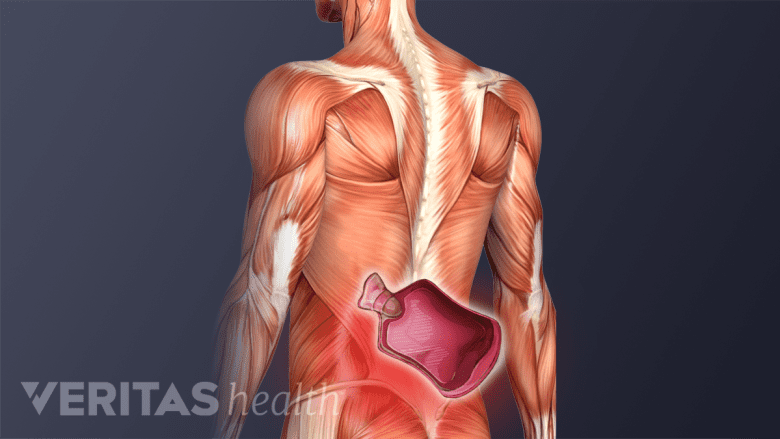Symptoms of pain, stiffness, and local tenderness in the lower back after shoveling snow typically indicates a muscle strain injury and can be relieved with self-care and simple home treatments.
See Lower Back Muscle Strain Symptoms
Back pain from a muscle strain is most intense for the initial few hours and days. It is normal to experience increased pain with certain movements or positions, such as bending forward, backward, or standing upright. The symptoms may persist while the muscles continue to heal, for 1 to 2 weeks, but the severity usually decreases during this time.
In This Article:
- Snow Shoveling Techniques to Prevent Low Back Injuries
- Relieving Lower Back Muscle Strain After Shoveling Snow
How to Relieve Back Pain after Snow Shoveling
The early treatments for lower back pain are simple, effective, and can help provide immediate relief from the painful symptoms of a muscle strain injury. This list describes simple and effective home treatments to ¬relieve back pain from a muscle strain.
Rest in moderation to calm the tissues
A short period of rest, for a few hours on the first day, can help calm sore muscles in the lower back and avoid sudden or unnecessary movements that may induce pain. Resting for several hours or days is not advisable, as too much inactivity can make the back stiff and healing more difficult.
Take over-the-counter (OTC) pain-relieving medication to reduce soreness
NSAIDs provide anti-inflammatory effects and help calm inflammation and pain in the back.
Oral and topical medication can be helpful when used independently or in combination; a trial-and-error of the type and combination of drugs may be needed to see the most effective options.
- Common OTC oral medications include ibuprofen, naproxen, and acetaminophen. Ibuprofen and naproxen belong to the non-steroidal anti-inflammatory drugs (NSAIDs) category, which alleviates lower back pain caused by swollen nerves or muscles. Acetaminophen works by interfering with pain signals sent to the brain. NSAIDs may cause side effects, such as stomach irritation. Health care practitioners typically advise they be used in moderation for short periods.
- Topical medications, which include preparations of capsaicin, menthol, lidocaine, NSAIDs, or trolamine salicylate, can help reduced localized pain without the risk of body-wide side effects.
See Medications for Back Pain and Neck Pain
If the pain is severe, oral and topical agents may be used together to reduce the acute symptoms.
Alternate cold and heat therapy to improve healing

Applying heat to the lower back enhances circulation and alleviates spasms and tension.
Inflammation from an acute injury may be calmed down with ice/cold therapy during the first 48 hours, followed by heat thereafter.
Ice or cold therapy from an ice pack or bag of frozen veggies, wrapped in a t-shirt or towel, can help constrict the blood vessels, reduce swelling, and decrease the pain immediately.
Heat from a warm bath, whirlpool, heat wrap, hot water bottle, electric heating pad, or chemical or adhesive heat wraps can relax tense muscles and improve blood flow. Increased blood flow brings nutrients and oxygen that muscles need to heal and stay healthy.
While ice therapy is used during the first couple of days after the muscle strain injury, heat therapy may be continued for several days to facilitate healing and restore the tissues.
See How to Apply Heat Therapy and Ice Massage for Back Pain Relief
Keep the lower back in an inclined position rather than sitting upright
Instead of sitting upright on a chair or couch, sitting at an incline on a reclining chair or the bed may be beneficial. Additionally, using pillows to prop the knees can take the stress off the lower back tissues.
Engage in simple stretching exercises to prevent stiffness
Hamstring stretches promote flexibility and reduce muscle tightness in the low back and legs.
Exercises that include gentle stretching of the lower back, buttocks, hips, and legs (especially the hamstring muscles) can improve blood flow to these areas and increase range of motion, preventing stiffness.
To prevent further injury, it is advisable to wait for a couple of weeks before engaging in intense workouts and other strenuous physical activities.
When to See a Doctor for Lower Back Pain after Shoveling Snow
Loss of control over bladder and bowel function requires immediate medical attention.
If the back pain symptoms persist, are not relieved with self-care, or worsen over time, seeking medical help is recommended.
The following warning signs may indicate a serious lower back condition that prompts immediate medical attention:
- Numbness in the groin or genital areas with loss of bladder and/or bowel control, indicating cauda equina syndrome
- A sudden feeling of weakness in the foot, and the inability to lift the foot, indicating foot drop
- Severe, unrelenting back pain with or without leg pain that does not subside with self-care, indicating a lumbar herniated disc or spondylolisthesis
It is recommended to seek medical attention for lower back pain that interferes with daily activities, mobility, or sleep. In addition to back pain, dehydration, lightheadedness, and heart attacks are also possible while or immediately after shoveling snow. As a general rule, it is advisable to get any concerning symptom evaluated by a medical professional.
When to Avoid Snow Shoveling Due to Back Pain
Individuals with a diagnosed lower back condition are advised to consult with their physician before engaging in strenuous activities, such as snow shoveling. If a recent trauma has occurred or surgery has been performed involving the spine, hip, and/or leg it is advisable to avoid shoveling snow altogether and hire help to remove snow and sand the driveway.
A less-stressful option to remove snow with back problems includes using a snow blower instead of a manual snow shovel. A snow blower is a machine with wheels that may be self-propelled or need to be pushed. The machine has a rotating motor that scoops the snow and throws it a few feet away.
Investing in a snow blower or hiring help to clear snow may be expensive, but the cost may be well worth it to prevent an injury or avoid making existing pain worse.
Read more about Lower Back Pain Symptoms, Diagnosis, and Treatment

